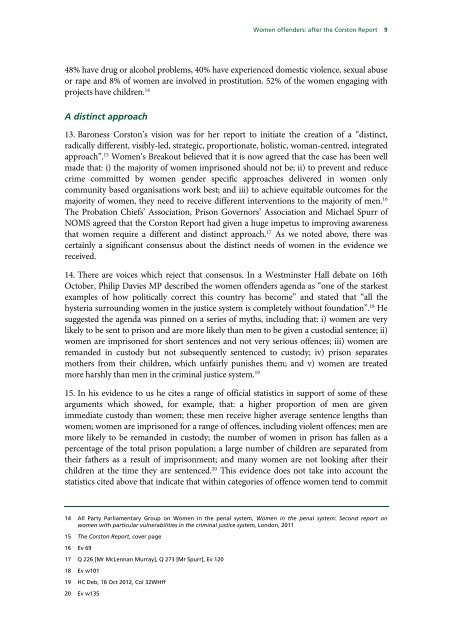Women offenders: after the Corston Report - United Kingdom ...
Women offenders: after the Corston Report - United Kingdom ...
Women offenders: after the Corston Report - United Kingdom ...
Create successful ePaper yourself
Turn your PDF publications into a flip-book with our unique Google optimized e-Paper software.
<strong>Women</strong> <strong>offenders</strong>: <strong>after</strong> <strong>the</strong> <strong>Corston</strong> <strong>Report</strong> 948% have drug or alcohol problems, 40% have experienced domestic violence, sexual abuseor rape and 8% of women are involved in prostitution. 52% of <strong>the</strong> women engaging withprojects have children. 14A distinct approach13. Baroness <strong>Corston</strong>’s vision was for her report to initiate <strong>the</strong> creation of a “distinct,radically different, visibly-led, strategic, proportionate, holistic, woman-centred, integratedapproach”. 15 <strong>Women</strong>’s Breakout believed that it is now agreed that <strong>the</strong> case has been wellmade that: i) <strong>the</strong> majority of women imprisoned should not be; ii) to prevent and reducecrime committed by women gender specific approaches delivered in women onlycommunity based organisations work best; and iii) to achieve equitable outcomes for <strong>the</strong>majority of women, <strong>the</strong>y need to receive different interventions to <strong>the</strong> majority of men. 16The Probation Chiefs’ Association, Prison Governors’ Association and Michael Spurr ofNOMS agreed that <strong>the</strong> <strong>Corston</strong> <strong>Report</strong> had given a huge impetus to improving awarenessthat women require a different and distinct approach. 17 As we noted above, <strong>the</strong>re wascertainly a significant consensus about <strong>the</strong> distinct needs of women in <strong>the</strong> evidence wereceived.14. There are voices which reject that consensus. In a Westminster Hall debate on 16thOctober, Philip Davies MP described <strong>the</strong> women <strong>offenders</strong> agenda as “one of <strong>the</strong> starkestexamples of how politically correct this country has become” and stated that “all <strong>the</strong>hysteria surrounding women in <strong>the</strong> justice system is completely without foundation”. 18 Hesuggested <strong>the</strong> agenda was pinned on a series of myths, including that: i) women are verylikely to be sent to prison and are more likely than men to be given a custodial sentence; ii)women are imprisoned for short sentences and not very serious offences; iii) women areremanded in custody but not subsequently sentenced to custody; iv) prison separatesmo<strong>the</strong>rs from <strong>the</strong>ir children, which unfairly punishes <strong>the</strong>m; and v) women are treatedmore harshly than men in <strong>the</strong> criminal justice system. 1915. In his evidence to us he cites a range of official statistics in support of some of <strong>the</strong>searguments which showed, for example, that: a higher proportion of men are givenimmediate custody than women; <strong>the</strong>se men receive higher average sentence lengths thanwomen; women are imprisoned for a range of offences, including violent offences; men aremore likely to be remanded in custody; <strong>the</strong> number of women in prison has fallen as apercentage of <strong>the</strong> total prison population; a large number of children are separated from<strong>the</strong>ir fa<strong>the</strong>rs as a result of imprisonment; and many women are not looking <strong>after</strong> <strong>the</strong>irchildren at <strong>the</strong> time <strong>the</strong>y are sentenced. 20 This evidence does not take into account <strong>the</strong>statistics cited above that indicate that within categories of offence women tend to commit14 All Party Parliamentary Group on <strong>Women</strong> in <strong>the</strong> penal system, <strong>Women</strong> in <strong>the</strong> penal system: Second report onwomen with particular vulnerabilities in <strong>the</strong> criminal justice system, London, 201115 The <strong>Corston</strong> <strong>Report</strong>, cover page16 Ev 6917 Q 226 [Mr McLennan Murray], Q 273 [Mr Spurr], Ev 12018 Ev w10119 HC Deb, 16 Oct 2012, Col 32WHff20 Ev w135
















